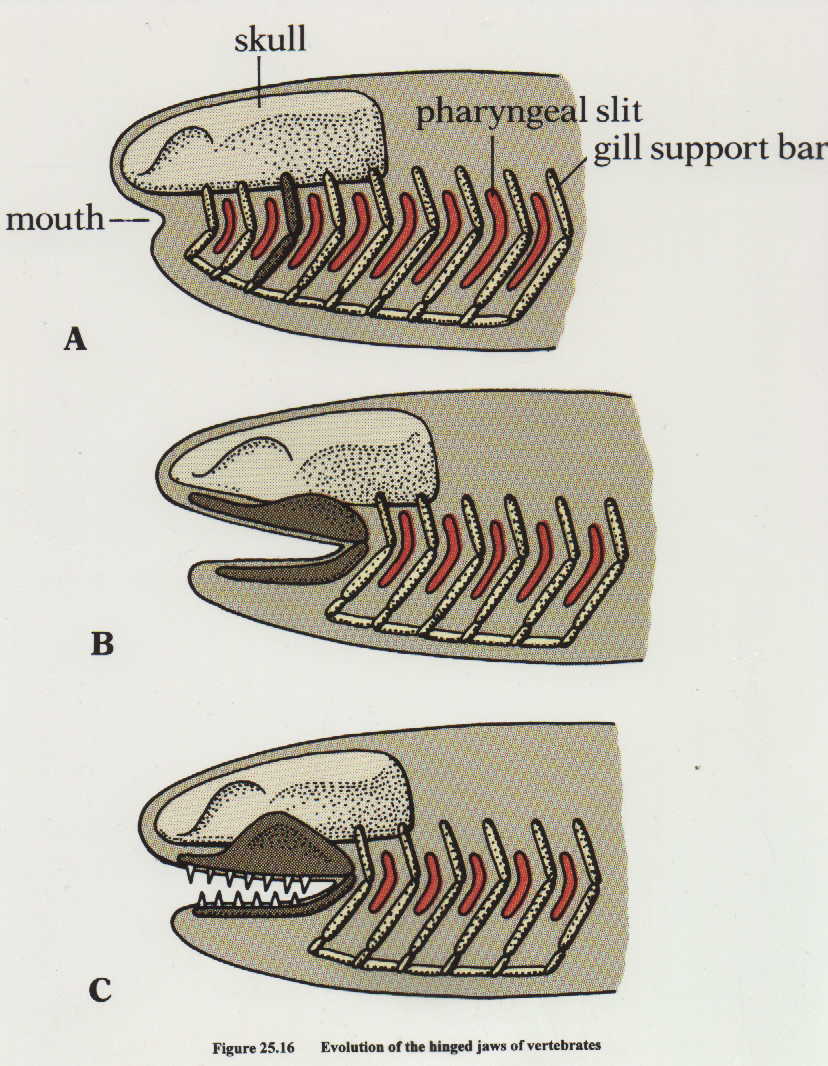
Vertebrates
I. Embryology of chordates - tunicates, lancets, acorn worms, vertebrates (pp 340-345)
A. All chordates have notochords, spinal cords and pharyngeal gill slits
B. All chordates go through gastrulation in a similar way
1. Blastula is the ball of cells formed from a zygote
2. Gastrula develops from an invagination of one side
a. presence of yolk influences gastrulation because those cells don't
move
b. gastrulation develops within discs of cells in animals with a large
yolk mass
3. Notochord develops from mesoderm after gastrulation
4. Notochords of many vertebrates disappear in adults
II. Evolution of the vertebrates
A. Jawless fishes (class Agnatha)
1. First vertebrates, lived during Silurian, 450 MYA
2. extant lampreys and hagfish (slime eels) have secondarily lost jaws
B. Fish with jaws
1. Decline of Agnathans was followed by rise of three other fishes with jaws
a. Placoderms - armored fish
b. Chondrichthyes - sharks and rays
i. replace bone with cartilage
ii. possess gills, but lack swim bladders and lungs
iii. have internal fertilization
c. Osteichthyes - bony fishes (18,000 spp)
i. primitive species (lobe-fins) possess gills and lungs
ii. derived species (ray-fins) possess gills, but lungs form the
swim bladder
iii. fish were the dominant vertebrates during the Devonian, 350
MYA
2. Jaws developed from gill arches

3. Exhibit internal and external fertilization
4. Circulatory system has one pump, e.g. a 1-chambered heart (pp 841-847)
C. Amphibians - salamanders, newts, frogs, toads
1. Evolved from lobe-finned fishes

2. Greatest diversity during Carboniferous
3. Many went extinct during Permian extinction
4. Circulatory system has 2-chambered heart, but not 2 separate systems
5. Much gas exchange occurs through skin - must live in moist environments
6. eggs cannot survive dessication, lack outer membranes
7. Most go through larval tadpole stage and then metamorphose into adults
D. Reptiles - turtles, lizards, snakes, alligators (polyphyletic)
1. First appeared in late Carboniferous
2. Diversified during Permian, dominant group, esp. dinosaurs, during Mesozoic
3. Internal fertilization, lay amniotic egg - tough membrane that protects
embryo
4. Larval stage occurs inside egg, hatch as miniature adults
5. Heart has more separate chambers, lack skin breathing
6. Stem reptiles (cotylosaurs) gave rise to
a. lizards
b. ichyosaurs and pleiosaurs
c. turtles
d. thecodonts, which gave rise to pterosaurs, crocodiles, dinosaurs,
and birds
e. therapsids, which gave rise to mammals
7. All dinosaurs went extinct at the end of the Cretaceous
E. Birds (class Aves, 9,000 spp)
1. Oldest fossil (Archeopteryx) from middle Jurassic, 150 MYA
2. possess feathers
3. are endothermic (warm-blooded) and have 4-chambered heart (as do crocodiles)
4. have mammal-like lung for gas exchange (p. 806)
5. hollow bones
6. all species lay eggs and provide some parental care
F. Mammals(4,100 spp)
1. Oldest fossils are Triassic, but diversified after Cretaceous extinction
event
2. Endothermic, four-chambered heart
3. possess fur (whales possess fur in utero, then lose it)
4. possess a diaphragm to increase breathing efficiency
5. ancestral jaw bones now form bones of the middle ear

6. eggs only laid by monotremes - platypus and echidna
7. females provide nutrition as milk
8. most speciose orders include rodents (1,500 spp) and bats (1,000 spp)